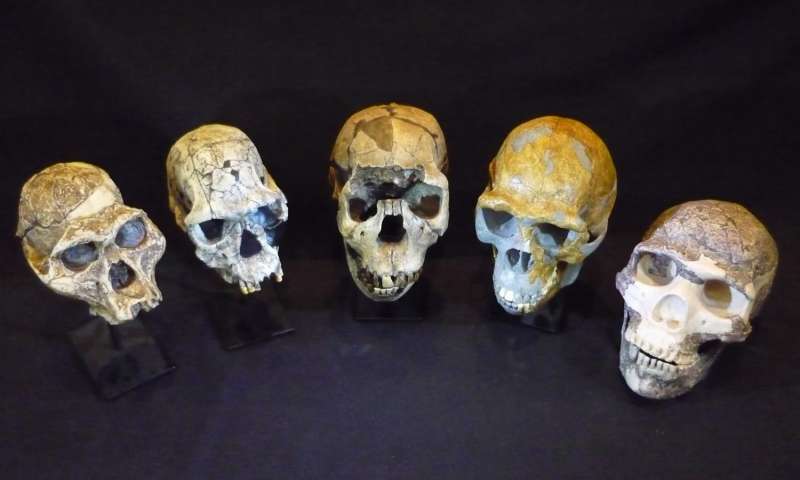
Left to right: Australopithecus afarensis, Homo habilis, Homo ergaster, Homo erectus and Homo neanderthalensis. Credit: Roger Seymour.
The current paradigm is that human intelligence became more complex as our brains became bigger. Australian and South African researchers, however, claim this is only one side of the picture. Their investigation revealed that increased blood flow to the brain might have more to do with enhancing cognition than brute brain size.
Using the size of two holes at the base of the skull which allow arteries to pass to the brain, the researchers were able to calculate how much blood used to flow through the brains of 11 species of hominin ancestors, from Australopithecus to archaic Homo sapiens. That’s a timeline that roughly covers the last 3.5 million years.
What they found was that the blood flow to the brain increased disproportionately with brain volume. The blood flow to brain volume exponent was found to be 1.4, as reported in Royal Society Open Science.
“Brain size has increased about 350% over human evolution, but we found that blood flow to the brain increased an amazing 600%,” says project leader Professor Emeritus Roger Seymour, from the University of Adelaide. “We believe this is possibly related to the brain’s need to satisfy increasingly energetic connections between nerve cells that allowed the evolution of complex thinking and learning.”
“To allow our brain to be so intelligent, it must be constantly fed oxygen and nutrients from the blood,” he added.
Of course, the more metabolically active the brain is, the more blood is required, but the new study shows blood flow and brain volume don’t increase in concert. Then again, human brains are somewhat special in the sense that they’re also very well packaged. Namely, brain folds in the familiar wrinkled nut-shape to allow more neural connections to form in a smaller volume. This might explain why arteries directing blood to the brain increased in size disproportionately to brain volume.
By using this clever proxy, namely the holes in the skull, researchers have now determined the intensity of brain activity in million-year-old ancestors — something that was previously believed to have been taken to the grave once these ancestors succumbed.
“Throughout evolution, the advance in our brain function appears to be related to the longer time it takes for us to grow out of childhood. It is also connected to family cooperation in hunting, defending territory and looking after our young,” said co-author Vanya Bosiocic.
“The emergence of these traits seems to nicely follow the increase in the brain’s need for blood and energy.”









